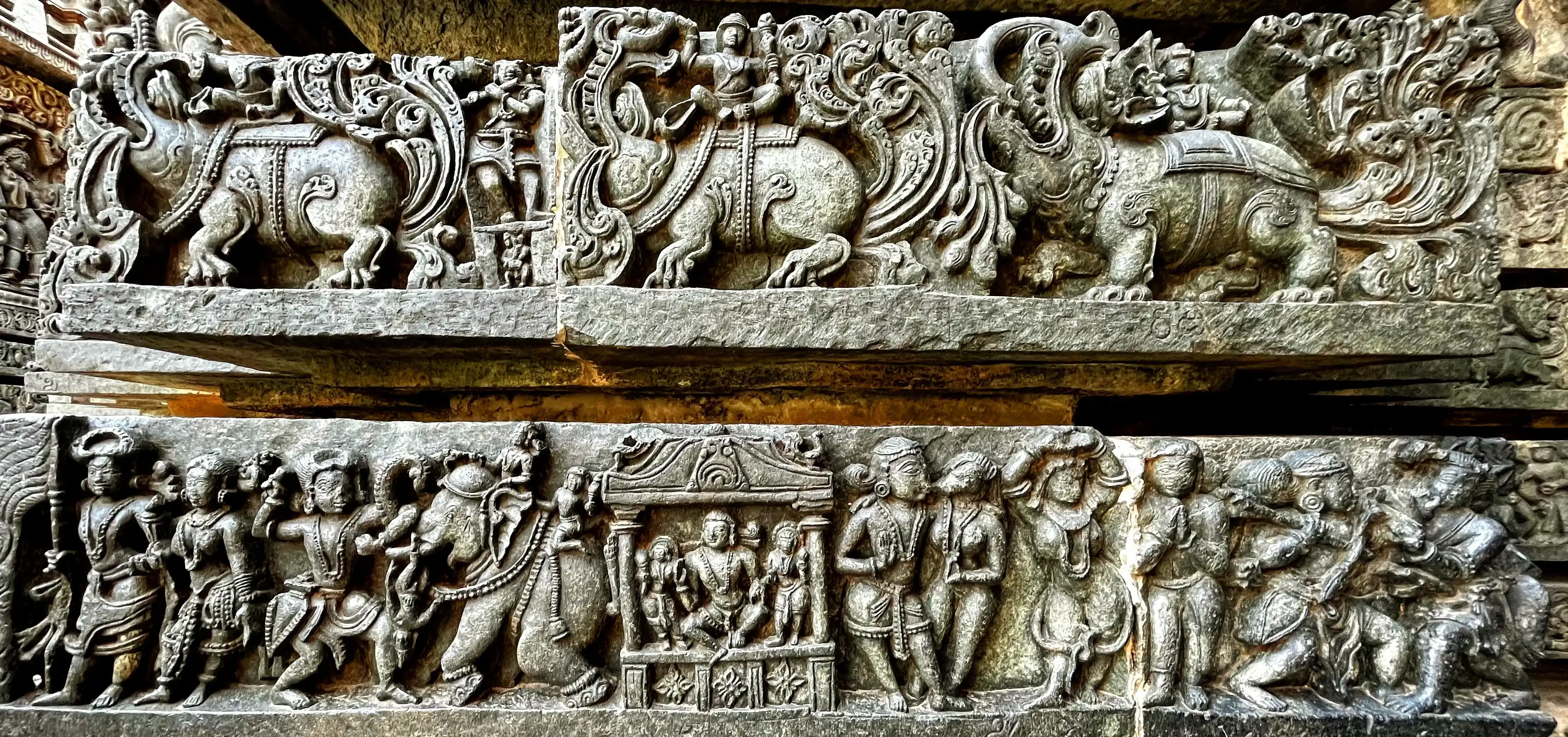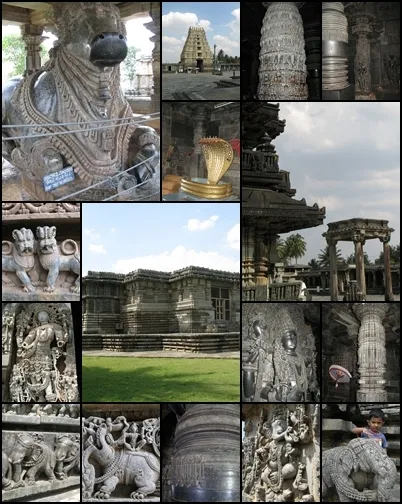
It has been a while since we ventured on NH-48 highway connecting Mangalore, KA with Solapur, MH; the last time we visited Shravanabelagola was in 2009. Since then, it had always been in discussion to visit Belur-Halebid, known for its Hoysala architecture. This time, we covered both Belur and Halebid along with Chikmaglur on a 3-day trip. We started at 7:10 AM from our parking lot and reached Halebid by 12 with two breaks - breakfast at Hotel Mayura and another at Hassan to use an ATM.
Compared to 2009, the road was significantly better, and the journey was smooth. However, there are still parts where road work is ongoing, and it is not yet a divided 4-lane highway. Around Kunigal, there are some bad potholes. Upon reaching Halebid, we hired a guide for 200 INR, which was, in fact, a must to understand the details and history. The entire architecture is made of soapstone. The guide used a small mirror to reflect the sunlight to explain intricate temple details.
Halebid’s patron God is Shiva, and the temple was built by the minister in honor of the King and the Queen. This is an incomplete construction where three generations of workers have worked, and in many places, you will notice ‘works in progress.’ It has suffered the most damage among the three - Somnathpura, Halebid, and Belur. Today, Halebidu in Kannada literally means ‘an old town’ to reflect its neglected past. It is unique with its two gigantic figures of Nandi (the sacred bull) - one of them houses Vishnuvardhana Hoysaleshwara (King), and the other Shanthaleshwara (Queen). The bulls are decorated with distinct male and female ornaments to signify to whom they belong. The temple walls are covered with figures of men in battles, dancing women, Hindu deities, birds, and animals. A stone platform is at the center of the hall where the queen used to dance for the Lord Chennakeshava. The temple stands in the middle of a peaceful park by the side of a lake.
Our guide enlightened us with an interesting tale that many sculptures were stolen and taken away by the British when they left India, and those idols are now gracing homes in England and elsewhere. It takes at least two hours to take a round of the temple exteriors. There is so much to see in just one temple that we completely lost track of time here.
The Jain basadi is very near to the Hoysaleswara temple and is equally rich in sculptural detail. They are famous for their pillars, which are highly polished, almost resembling mirrors. The first is Parshwanatha basadi - this complex consists of three temples. The most famous is the Parswanathaswamy Temple, which has a 14-ft high figure made of black stone. A seven-headed serpent has been imprinted on the head of this figure. Adinathaswamy (central mandir) and Shanthinathaswamy are the other two temples here.
At the road end, there is the Kedareshwara temple, but no one except us was visiting the temple. Although it shares the same architectural elements with its neighbor, it is a miniature of the former.

From here, we went to Belur, which is just 16 km apart, and it is a living town. The entrance to both the Hoysaleshwara temple and the Chennakeshava temple is free. The Chennakeshava Temple in Belur is dedicated to the Hindu god Vishnu, and active worship still goes on in this temple, while the Halebid temple, though open to the public, is no longer in use for devotional purposes. Like the Hoysaleshwara Temple, the Chennakeshava temple is star-shaped and stands on a platform. Everything from elephants, episodes from the epics, to sensuous dancers is meticulously carved. Forty-six pillars support the extensive hall, each with a different design. The Narasimha pillar is particularly captivating.
The sculpted inner and outer walls of the temple tell a tale of dedication and sheer hard work by the craftsmen. Each figure is carved to perfection, seemingly ready to come to life at any moment. The celestial beauties depict the lifestyles of that time, showing dancers, shringar, and even scenes of feeding pets. The walls of the star-shaped temple are literally covered with sculptures in stone that depict various events from the epics of Ramayana and Mahabharata. The star design starts from the platform and goes all the way up the walls and up to the top of the shikhara.
We skipped lunch to cover this area and reach Chikmaglur before dusk. A day is enough to explore both sites if you are not too bored with sculptures. In Belur, we didn’t hire a guide, which we regretted later.
P.S. As mentioned by Mr. Bhat, worship continues in Halebid temple.
